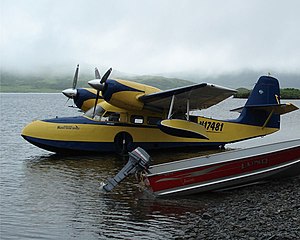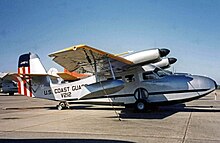
The Grumman S-2 Tracker was the first purpose-built, single airframe anti-submarine warfare (ASW) aircraft to enter service with the United States Navy. Designed and initially built by Grumman, the Tracker was of conventional design — propeller-driven with twin radial engines, a high wing that could be folded for storage on aircraft carriers, and tricycle undercarriage. The type was exported to a number of navies around the world. Introduced in 1952, the Tracker and its E-1 Tracer derivative saw service in the U.S. Navy until the mid-1970s, and its C-1 Trader derivative until the mid-1980s, with a few aircraft remaining in service with other air arms into the 21st century. Argentina and Brazil are the last countries to still use the Tracker.
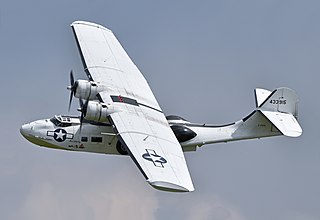
The Consolidated Model 28, more commonly known as the PBY Catalina, is a flying boat and amphibious aircraft that was produced in the 1930s and 1940s. In Canadian service it was known as the Canso. It was one of the most widely used seaplanes of World War II. Catalinas served with every branch of the United States Armed Forces and in the air forces and navies of many other nations. The last military PBYs served until the 1980s. As of 2021, 86 years after its first flight, the aircraft continues to fly as a waterbomber in aerial firefighting operations in some parts of the world.

A maritime patrol aircraft (MPA), also known as a patrol aircraft, maritime reconnaissance aircraft, maritime surveillance aircraft, or by the older American term patrol bomber, is a fixed-wing aircraft designed to operate for long durations over water in maritime patrol roles — in particular anti-submarine warfare (ASW), anti-ship warfare (AShW), and search and rescue (SAR).
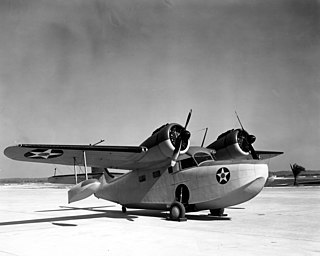
The Grumman G-21 Goose is an amphibious flying boat designed by Grumman to serve as an eight-seat "commuter" aircraft for businessmen in the Long Island area. The Goose was Grumman's first monoplane to fly, its first twin-engined aircraft, and its first aircraft to enter commercial airline service. During World War II, the Goose became an effective transport for the US military, as well as serving with many other air forces. During hostilities, the Goose took on an increasing number of combat and training roles.

German submarine U-166 was a Type IXC U-boat of Nazi Germany's Kriegsmarine during World War II. The submarine was laid down on 6 December 1940 at the Seebeckwerft at Wesermünde as yard number 705, launched on 1 November 1941, and commissioned on 23 March 1942 under the command of Oberleutnant zur See Hans-Günther Kuhlmann. After training with the 4th U-boat Flotilla, U-166 was transferred to the 10th U-boat Flotilla for front-line service on 1 June 1942. The U-boat sailed on only two war patrols and sank four ships totalling 7,593 gross register tons (GRT). She was sunk on 30 July 1942 in the Gulf of Mexico.

The Grumman OV-1 Mohawk is an American armed military observation and attack aircraft that was designed for battlefield surveillance and light strike capabilities. It has a twin turboprop configuration, and carries two crew members in side-by-side seating. The Mohawk was intended to operate from short, unimproved runways in support of United States Army maneuver forces.

The Grumman HU-16 Albatross is a large, twin–radial engined amphibious seaplane that was used by the United States Air Force (USAF), the U.S. Navy (USN), and the U.S. Coast Guard (USCG), primarily as a search and rescue (SAR) aircraft. Originally designated as the SA-16 for the USAF and the JR2F-1 and UF-1 for the USN and USCG, it was redesignated as the HU-16 in 1962. A new build G-111T Albatross with modern avionics and engines was proposed in 2021 with production in Australia to commence in 2025.
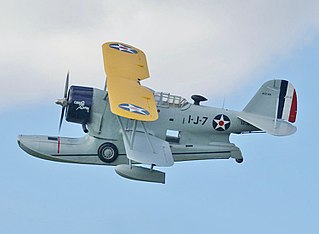
The Grumman J2F Duck is an American single-engine amphibious biplane. It was used by each major branch of the U.S. armed forces from the mid-1930s until just after World War II, primarily for utility and air-sea rescue duties. It was also used by the Argentine Navy, who took delivery of their first example in 1937. After the war, J2F Ducks saw service with independent civilian operators, as well as the armed forces of Colombia and Mexico.

The Attacker class were a class of escort aircraft carriers in service with the British Royal Navy during the Second World War.
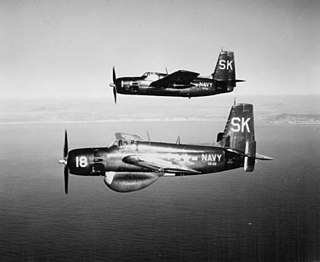
The Grumman AF Guardian is the first purpose-built anti-submarine warfare (ASW) carrier-based aircraft to enter service with the United States Navy. It consisted of two airframe variants, one for detection gear, the other for weapons. The Guardian remained in service until August 1955, when it was replaced by the twin-engined Grumman S-2 Tracker. The Guardian was the largest single-engine piston-powered carrier aircraft ever to see service.

The Sikorsky VS-44 was a large four-engined flying boat built in the United States in the early 1940s by Sikorsky Aircraft. Based on the XPBS-1 patrol bomber, the VS-44 was designed primarily for the transatlantic passenger market, with a capacity of 40+ passengers. Three units were produced: Excalibur, Excambian, and Exeter, plus two XPBS-1 prototypes.

The Civil Air Patrol (CAP) is the civilian auxiliary of the United States Air Force (USAF). It was created by Administrative Order 9 in December 1941, with Maj. Gen. John F. Curry as the first CAP national commander. The organization was originally formed to provide civilian air support to aid the war effort of World War II through border and coastal patrols, military training assistance, courier services and other activities. These efforts were recognized and, after the close of the war, Civil Air Patrol was transferred from the United States Army to the newly formed U.S. Air Force. Through the enactment of Public Law 79-476 by the U.S. Congress and signed by President Harry S. Truman, Civil Air Patrol was incorporated as a nonprofit organization of "volunteers and declared to be of a benevolent nature, never again to be involved in direct combat activities."

The Curtiss HS was a single-engined patrol flying boat built for the United States Navy during World War I. Large numbers were built from 1917 to 1919, with the type being used to carry out anti-submarine patrols from bases in France from June 1918. It remained in use with the US Navy until 1928, and was also widely used as a civil passenger and utility aircraft.

Coast Guard Air Station Salem was a United States Coast Guard air station located in Salem, Massachusetts from 1935 to 1970. Its area of coverage extended from New York City to the Canada–United States border.

The National Navy of Uruguay is a branch of the Armed Forces of Uruguay under the direction of the Ministry of National Defense and the commander in chief of the Navy.
Naval Air Station DeLand was a United States Naval Air Station located in DeLand, Florida from 1942 to 1946. After the war, the airfield and associated infrastructure was redeveloped into DeLand Municipal Airport.
"De plane! De plane!", or "The plane! The plane!", is a catchphrase originating from the opening titles of every episode of the U.S. TV series Fantasy Island (1977–1984). Each episode began with the diminutive Tattoo, one of the main characters, spotting the seaplane approaching the island and running up a tower and excitedly yelling, "De Plane! De Plane!" and ringing a bell.

The Royal Australian Navy operated Grumman S-2 Tracker anti-submarine warfare aircraft from 1967 to 1984. The type flew from the aircraft carrier HMAS Melbourne and shore bases. A total of 32 Trackers were purchased in two batches which were delivered in 1967 and 1977.
